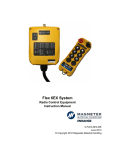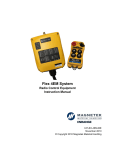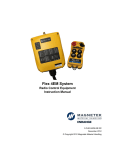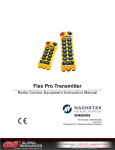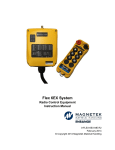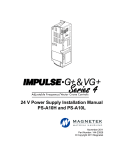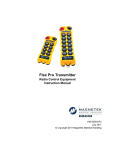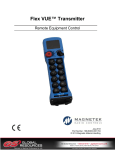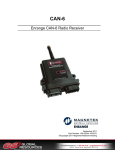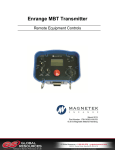Download Magnetek Flex 12RS System Instruction manual
Transcript
Flex PRO / Flex M Pre-Engineered Radio Control System Part Number: 191-00195-1200 April 2012 © 2012 Magnetek Material Handling TABLE OF CONTENTS 1. INTRODUCTION....................................................................................................................................... 6 2. RADIO CONTROLLED SAFETY ............................................................................................................. 7 2.1. WARNINGS AND CAUTIONS .............................................................................................................. 7 2.2. CRITICAL INSTALLATION CONSIDERATIONS ................................................................................ 8 2.3. GENERAL ........................................................................................................................................... 8 2.4. PERSONS AUTHORIZED TO OPERATE RADIO CONTROLLED CRANES ..................................... 8 2.5. SAFETY INFORMATION AND RECOMMENDED TRAINING FOR RADIO CONTROLLED EQUIPMENT OPERATORS ...................................................................................................................... 9 2.6. TRANSMITTER UNIT ....................................................................................................................... 10 2.7. PRE-OPERATION TEST .................................................................................................................. 10 2.8. BATTERIES ...................................................................................................................................... 11 2.9. BATTERY HANDLING ...................................................................................................................... 11 2.10. BATTERY CHARGING ................................................................................................................... 11 2.11. BATTERY DISPOSAL ..................................................................................................................... 11 2.12. SPECIFIC SYSTEM WARNINGS ................................................................................................... 12 2.13. FLEX M RECEIVER INSTALLATION .............................................................................................. 12 2.14. PRE-INSTALLATION ...................................................................................................................... 12 3. GENERAL TRANSMITTER INFORMATION ......................................................................................... 13 3.1. EXTERNAL ILLUSTRATION (PRO 12 CONFIGURATION).............................................................. 13 3.2. INTERNAL ILLUSTRATION (PRO 12 CONFIGURATION) ............................................................... 14 3.3. TYPES OF BUTTONS ...................................................................................................................... 15 3.4. ADJUSTABLE SPEED CONTROL ................................................................................................... 15 4. DIP SWITCH SETTINGS ........................................................................................................................ 16 4.1. SYSTEM CHANNEL SETTINGS ...................................................................................................... 16 4.2. INACTIVITY TIME OUT TIMER ........................................................................................................ 17 4.3. A/B/BOTH SELECT .......................................................................................................................... 17 5. SYSTEM CHANNEL TABLE .................................................................................................................. 18 6. OPERATING PROCEDURE ................................................................................................................... 19 6.1. GENERAL OPERATING PROCEDURE ........................................................................................... 19 6.2. CHANGING TRANSMITTER BATTERIES ....................................................................................... 20 7.0 RECEIVER MECHANICAL DRAWINGS .............................................................................................. 21 7.1. MECHANICAL LAYOUTS ................................................................................................................. 21 7.2. RECEIVER INSTALLATION ............................................................................................................. 23 7.3. REMOVAL......................................................................................................................................... 24 8. NORMAL OPERATION .......................................................................................................................... 25 8.1. POWER SUPPLY MODULE ............................................................................................................. 25 8.2. RF/CPU MODULE ............................................................................................................................ 25 8.3. RELAY MODULE(S) ......................................................................................................................... 25 8.4. ANALOG I/O MODULE(S) ................................................................................................................ 25 9. FLEX MODULE TYPES.......................................................................................................................... 27 9.1. FLEX RF/CPU MODULE .................................................................................................................. 27 9.2. FLEX M POWER SUPPLY MODULE................................................................................................ 28 9.3. FLEX M RELAY MODULE ................................................................................................................ 29 9.4. FLEX M ANALOG I/O MODULE ....................................................................................................... 30 Flex PRO / Flex M Pre-Engineered Radio Control System Instruction Manual April 2012 Page 2 of 42 10. RECEIVER CHANNEL CONFIGURATION SETTINGS (BANK 2 ON RF/CPU MODULE) .............. 32 10.1. CHANNEL DIP SWITCH SETTINGS FOR 433MHZ PART 15, VERSION 2 RF/CPU MODULE (25-02074-816E) ................................................................................................................................................ 33 10.2. FLEX M 24 AND 32 RELAY PRE-ENGINEERED WIRING ............................................................. 34 10.3. FCC STATEMENTS ........................................................................................................................ 36 11. TROUBLESHOOTING .......................................................................................................................... 37 11.1. TRANSMITTER STATUS LIGHT INDICATORS & WARNINGS ...................................................... 37 11.2. TRANSMITTER PUSH BUTTON ERROR TABLE .......................................................................... 38 11.3. TROUBLESHOOTING TABLE ........................................................................................................ 39 11.4. ASSEMBLY AND REPLACEMENT PARTS .................................................................................... 41 12. NOTES .................................................................................................................................................. 42 Flex PRO / Flex M Pre-Engineered Radio Control System Instruction Manual April 2012 Page 3 of 42 PRODUCT MANUAL SAFETY INFORMATION Magnetek, Inc. (Magnetek) offers a broad range of radio remote control products, control products and adjustable frequency drives, and industrial braking systems for material handling applications. This manual has been prepared by Magnetek to provide information and recommendations for the installation, use, operation and service of Magnetek’s material handling products and systems (Magnetek Products). Anyone who uses, operates, maintains, services, installs or owns Magnetek Products should know, understand and follow the instructions and safety recommendations in this manual for Magnetek Products. The recommendations in this manual do not take precedence over any of the following requirements relating to cranes, hoists lifting devices or other material handling equipment which use or include Magnetek Products: • • • • • Instructions, manuals, and safety warnings of the manufacturers of the equipment where the radio system is used, Plant safety rules and procedures of the employers and the owners of facilities where the Magnetek Products are being used, Regulations issued by the Occupational Health and Safety Administration (OSHA), Applicable local, state or federal codes, ordinances, standards and requirements, or Safety standards and practices for the industries in which Magnetek Products are used. This manual does not include or address the specific instructions and safety warnings of these manufacturers or any of the other requirements listed above. It is the responsibility of the owners, users and operators of the Magnetek Products to know, understand and follow all of these requirements. It is the responsibility of the employer to make its employees aware of all of the above listed requirements and to make certain that all operators are properly trained. No one should use Magnetek Products prior to becoming familiar with and being trained in these requirements and the instructions and safety recommendations in this manual. WARRANTY INFORMATION For information on Magnetek’s product warranties by product type, please visit www.magnetekmh.com. Flex PRO / Flex M Pre-Engineered Radio Control System Instruction Manual April 2012 Page 4 of 42 Your New Flex PRO/Flex M Radio Control System ® Thank you for your purchase of Magnetek’s Enrange brand Flex PRO/Flex M Radio Remote Equipment Control. Magnetek has set a whole new standard in radio-remote performance, dependability, and value with this line of modular receivers. If your product ever needs modification or service, please contact one of our representatives at the following locations: U.S. Service Information For questions regarding service or technical information contact: 1.866.MAG.SERV 1.866.624.7378 World Headquarters: Magnetek, Inc. N49 W13650 Campbell Drive Menomonee Falls, WI 53051 Phone: 1.800.288.8178 Fax: 1.800.298.3503 Magnetek, Inc. has additional satellite locations for Canada and the United States. For more information, please visit http://www.magnetekmh.com. ©2012 MAGNETEK All rights reserved. This notice applies to all copyrighted materials included with this product, including, but not limited to, this manual and software embodied within the product. This manual is intended for the sole use of the person(s) to whom it was provided, and any unauthorized distribution of the manual or dispersal of its contents is strictly forbidden. This manual may not be reproduced in whole or in part by any means whatsoever without the expressed written permission of MAGNETEK. Flex PRO / Flex M Pre-Engineered Radio Control System Instruction Manual April 2012 Page 5 of 42 1. INTRODUCTION The Flex radio remote control systems are designed for control of industrial equipment and machinery such as overhead traveling cranes, jib cranes, gantry cranes, tower cranes, electric hoists, winches, monorails, conveyor belts, mining equipment and other material handling equipment where wireless control is preferred. Each Flex system consists of a transmitter handset and standard-equipped accessories such as a transmitter waist belt, spare transmitter power key, clear vinyl pouch, “AA” alkaline batteries, compass direction decal sheet and user’s manual. List of notable features include: • 32 user-programmable channels – Advanced synthesized RF controls with 32 built-in channels; there are no more fixed channel and fragile quartz crystals to break. • Over one million unique ID codes (20bit) – Each and every Flex system has its own unique ID code; no repeats. • Advanced controls – The Flex system utilizes advanced microprocessor controls with 16bit CRC which provides ultra-fast, safe, precise, and error-free encoding and decoding. • Unique I-CHIP design – The I-CHIP functions in a way that is very similar to SIM cards used on mobile phones, with the ability to transfer system information and settings from one transmitter to another without the hassle of resetting the spares. • Reliable push buttons – The in-house designed push buttons are rated for more than one million press cycles. • Low power consumption – Requires only two “AA” Alkaline batteries for more than 100 hours of operating time between replacements. • Ultra-durable nylon and fiberglass composite enclosures – Highly resistant to breakage and deformation even in the most abusive environments. • Full compliance – All systems are fully compliant with the FCC Part-15 Rules and Industry Canada Specifications (IC). • System Versatility – The Flex PRO/Flex M Radio Control Systems are able to control up to 4 motions (or 3 motions with A/B Select) with the Flex 8 PRO transmitter or up to 6 motions (or 5 motions with A/B Select) with the Flex 12 PRO transmitter. Flex PRO / Flex M Pre-Engineered Radio Control System Instruction Manual April 2012 Page 6 of 42 2. RADIO CONTROLLED SAFETY 2.1. WARNINGS AND CAUTIONS Throughout this document WARNING and CAUTION statements have been deliberately placed to highlight items critical to the protection of personnel and equipment. WARNING – A warning highlights an essential operating or maintenance procedure, practice, etc. which, if not strictly observed, could result in injury or death of personnel, or long term physical hazards. Warnings are highlighted as shown below: WARNING CAUTION – A caution highlights an essential operating or maintenance procedure, practice, etc. which, if not strictly observed, could result in damage to or destruction of equipment, or loss of functional effectiveness. Cautions are highlighted as shown below: CAUTION WARNINGS and CAUTIONS SHOULD NEVER BE DISREGARDED. The safety rules in this section are not intended to replace any rules or regulations of any applicable local, state, or federal governing organizations. Always follow your local lockout and tagout procedure when maintaining any radio equipment. The following information is intended to be used in conjunction with other rules or regulations already in existence. It is important to read all of the safety information contained in this section before installing or operating the Radio Control System. Flex PRO / Flex M Pre-Engineered Radio Control System Instruction Manual April 2012 Page 7 of 42 2.2. CRITICAL INSTALLATION CONSIDERATIONS WARNING PRIOR TO INSTALLATION AND OPERATION OF THIS EQUIPMENT, READ AND DEVELOP AN UNDERSTANDING OF THE CONTENTS OF THIS MANUAL AND THE OPERATION MANUAL OF THE EQUIPMENT OR DEVICE TO WHICH THIS EQUIPMENT WILL BE INTERFACED. FAILURE TO FOLLOW THIS WARNING COULD RESULT IN SERIOUS INJURY OR DEATH AND DAMAGE TO EQUIPMENT. ALL EQUIPMENT MUST HAVE A MAINLINE CONTACTOR INSTALLED AND ALL TRACKED CRANES, HOISTS, LIFTING DEVICES, AND SIMILAR EQUIPMENT MUST HAVE A BRAKE INSTALLED. FAILURE TO FOLLOW THIS WARNING COULD RESULT IN SERIOUS INJURY OR DEATH AND DAMAGE TO EQUIPMENT. AN AUDIBLE AND/OR VISUAL WARNING MEANS MUST BE PROVIDED ON ALL REMOTE CONTROLLED EQUIPMENT AS REQUIRED BY CODE, REGULATION, OR INDUSTRY STANDARD. THESE AUDIBLE AND/OR VISUAL WARNING DEVICES MUST MEET ALL GOVERNMENTAL REQUIREMENTS. FAILURE TO FOLLOW THIS WARNING COULD RESULT IN SERIOUS INJURY OR DEATH AND DAMAGE TO EQUIPMENT. FOLLOW YOUR LOCAL LOCKOUT TAGOUT PROCEDURE BEFORE MAINTAINING ANY REMOTE CONTROLLED EQUIPMENT. ALWAYS REMOVE ALL ELECTRICAL POWER FROM THE CRANE, HOIST, LIFTING DEVICE, OR SIMILAR EQUIPMENT BEFORE ATTEMPTING ANY INSTALLATION PROCEDURES. DE-ENERGIZE AND TAGOUT ALL SOURCES OF ELECTRICAL POWER BEFORE TOUCH-TESTING ANY EQUIPMENT. FAILURE TO FOLLOW THIS WARNING COULD RESULT IN SERIOUS INJURY OR DEATH AND DAMAGE TO EQUIPMENT. THE DIRECT OUTPUTS OF THIS PRODUCT ARE NOT DESIGNED TO INTERFACE DIRECTLY TO TWO STATE SAFETY CRITICAL MAINTAINED FUNCTIONS, I.E. MAGNETS, VACUUM LIFTS, PUMPS, EMERGENCY EQUIPMENT, ETC. A MECHANICALLY LOCKING INTERMEDIATE RELAY SYSTEM WITH SEPARATE POWER CONSIDERATIONS MUST BE PROVIDED. FAILURE TO FOLLOW THIS WARNING COULD RESULT IN SERIOUS INJURY OR DEATH AND DAMAGE TO EQUIPMENT. 2.3. GENERAL Radio controlled material handling equipment operates in several directions. Cranes, hoists, lifting devices, and other material handling equipment can be large, and operate at high speeds. Quite frequently, the equipment is operated in areas where people are working in close proximity to the material handling equipment. The operator must exercise extreme caution at all times. Workers must constantly be alert to avoid accidents. The following recommendations have been included to indicate how careful and thoughtful actions may prevent injuries, damage to equipment, or even save a life. 2.4. PERSONS AUTHORIZED TO OPERATE RADIO CONTROLLED CRANES Only properly trained persons designated by management should be permitted to operate radio controlled equipment. Radio controlled cranes, hoists, lifting devices and other material handling equipment should not be operated by any person who cannot read or understand signs, notices and operating instructions that pertain to the equipment. Radio controlled equipment should not be operated by any person with insufficient eyesight or hearing or by any person who may be suffering from a disorder or illness, is taking any medication that may cause loss of equipment control, or is under the influence of alcohol or drugs. Flex PRO / Flex M Pre-Engineered Radio Control System Instruction Manual April 2012 Page 8 of 42 2.5. SAFETY INFORMATION AND RECOMMENDED TRAINING FOR RADIO CONTROLLED EQUIPMENT OPERATORS Anyone being trained to operate radio controlled equipment should possess as a minimum the following knowledge and skills before using the radio controlled equipment. The operator should: • have knowledge of hazards pertaining to equipment operation • have knowledge of safety rules for radio controlled equipment • have the ability to judge distance of moving objects • know how to properly test prior to operation • be trained in the safe operation of the radio transmitter as it pertains to the crane, hoist, lifting device or other material handling equipment being operated • have knowledge of the use of equipment warning lights and alarms • have knowledge of the proper storage space for a radio control transmitter when not in use • be trained in transferring a radio control transmitter to another person • be trained how and when to report unsafe or unusual operating conditions • test the transmitter emergency stop and all warning devices prior to operation; testing should be done on each shift, without a load • be thoroughly trained and knowledgeable in proper and safe operation of the crane, hoist, lifting device, or other material handling equipment that utilizes the radio control • know how to keep the operator and other people clear of lifted loads and to avoid “pinch” points • continuously watch and monitor status of lifted loads • know and follow cable and hook inspection procedures • know and follow the local lockout and tagout procedures when servicing radio controlled equipment • know and follow all applicable operating and maintenance manuals, safety procedures, regulatory requirements, and industry standards and codes The operator shall not: • lift or move more than the rated load • operate the material handling equipment if the direction of travel or function engaged does not agree with what is indicated on the controller • use the crane, hoist, or lifting device to lift, support or transport people • lift or carry any loads over people • operate the crane, hoist, or lifting device unless all persons, including the operator, are and remain clear of the supported load and any potential pinch points Flex PRO / Flex M Pre-Engineered Radio Control System Instruction Manual April 2012 Page 9 of 42 • operate a crane, hoist, or lifting device when the device is not centered over the load • operate a crane, hoist, or lifting device if the chain or wire rope is not seated properly in the sprockets, drum or sheave • operate any damaged or malfunctioning crane, hoist, lifting device, or other material handling equipment • change any settings or controls without authorization and proper training • remove or obscure any warning or safety labels or tags • leave any load unattended while lifted • leave power on the radio controlled equipment when the equipment is not in operation • operate any material handling equipment using a damaged controller because the unit may be unsafe • operate manual motions with other than manual power • operate radio controlled equipment when low battery indicator is on WARNING THE OPERATOR SHOULD NOT ATTEMPT TO REPAIR ANY RADIO CONTROLLER. IF ANY PRODUCT PERFORMANCE OR SAFETY CONCERNS ARE OBSERVED, THE EQUIPMENT SHOULD IMMEDIATELY BE TAKEN OUT OF SERVICE AND BE REPORTED TO THE SUPERVISOR. DAMAGED AND INOPERABLE RADIO CONTROLLER EQUIPMENT SHOULD BE RETURNED TO MAGNETEK FOR EVALUATION AND REPAIR. FAILURE TO FOLLOW THIS WARNING COULD RESULT IN SERIOUS INJURY OR DEATH AND DAMAGE TO EQUIPMENT. 2.6. TRANSMITTER UNIT Transmitter switches should never be mechanically blocked ON or OFF. When not in use, the operator should turn the transmitter OFF. A secure storage space should be provided for the transmitter unit, and the transmitter unit should always be placed there when not in use. This precaution will help prevent unauthorized people from operating the material handling equipment. Spare transmitters should be stored in a secure storage space and only removed from the storage space after the current transmitter in use has been turned OFF, taken out of the service area and secured. 2.7. PRE-OPERATION TEST At the start of each work shift, or when a new operator takes control of the crane, operators should do, as a minimum, the following steps before making lifts with any crane or hoist: Test all warning devices. Test all direction and speed controls. Test the transmitter emergency stop. Flex PRO / Flex M Pre-Engineered Radio Control System Instruction Manual April 2012 Page 10 of 42 2.8. BATTERIES WARNING KNOW AND FOLLOW PROPER BATTERY HANDING, CHARING, AND DISPOSAL PROCEDURES. IMPROPER BATTERY PROCEDURES CAN CAUSE BATTERIES TO EXPLODE OR DO OTHER SERIOUS DAMAGE. FAILURE TO FOLLOW THIS WARNING COULD RESULT IN SERIOUS INJURY OR DEATH AND DAMAGE TO EQUIPMENT. 2.9. BATTERY HANDLING Use only batteries approved by Magnetek for the specific product. Do not dispose of a battery pack in fire; it may explode. Do not attempt to open the battery pack. Do not short circuit the battery. For intrinsically safe environments only use specified Magnetek intrinsically safe batteries. Keep the battery pack environment cool during charging operation and storage (i.e., not in direct sunlight or close to a heating source). 2.10. BATTERY CHARGING For those transmitters equipped with battery chargers, please familiarize all users with the instructions of the charger before attempting to use. Do not attempt to charge non-rechargeable battery packs. Avoid charging partially discharged rechargeable batteries to help prolong battery cycle life. Avoid charging the battery pack for more than 24 hours at a time. Do not charge batteries in a hazardous environment. Do not short the charger. Do not attempt to charge a damaged battery. Use only Magnetek approved chargers for the appropriate battery pack. Do not attempt to use a battery that is leaking, swollen, or corroded. Charger units are not intended for outdoor use. Use only indoors. 2.11. BATTERY DISPOSAL Before disposing of batteries consult local and governmental regulatory requirements for proper disposal procedure. Flex PRO / Flex M Pre-Engineered Radio Control System Instruction Manual April 2012 Page 11 of 42 2.12. SPECIFIC SYSTEM WARNINGS Below are some specific operating safety tips that should be strictly followed when operating a Flex Pro system: 1. Check the Status LED on the transmitter for any signs of low battery power (refer to Section 11.1). 2. Check the Status LED on the transmitter for any signs of irregularities (refer to Section 11.1). 3. Make sure the system is not set to the same channel as any other Flex systems in use within a distance of 300 meters (900 feet). 4. Never operate equipment with two transmitter handsets at the same time unless they are programmed to do so. 2.13. FLEX M RECEIVER INSTALLATION WARNING BEFORE OPERATING THE RECEIVER FAMILIARIZE YOURSELF WITH ALL SAFETY INFORMATION IN THIS MANUAL, APPROPRIATE MANUAL SUPPLEMENTS AND ANY OTHER LOCAL, STATE, OR FEDERAL RULES OR REGULATIONS ALREADY IN EXISTENCE. FAILURE TO FOLLOW THIS WARNING COULD RESULT IN SERIOUS INJURY OR DEATH AND DAMAGE TO EQUIPMENT. 2.14. PRE-INSTALLATION 1. 2. 3. 4. 5. Transmitter and receiver access code and channel must match before the system will communicate. Be aware of other radio channels in the surrounding area - set your system to a unique channel. Make sure that your equipment is working properly in manual mode prior to system installation. Make sure the power to the receiver is the correct voltage. Disconnect equipment power prior to system installation. Flex PRO / Flex M Pre-Engineered Radio Control System Instruction Manual April 2012 Page 12 of 42 3. GENERAL TRANSMITTER INFORMATION 3.1. EXTERNAL ILLUSTRATION (PRO 12 CONFIGURATION) Figure 1 E. Emergency Stop Button S. Removable Power Key Switch 1. Push Button #1 2. Push Button #2 3. Push Button #3 4. Push Button #4 5. Push Button #5 Figure 2 6. Push Button #6 7. Push Button #7 8. Push Button #8 9. Push Button #9 10. Push Button #10 11. Push Button #11 12. Push Button #12 SC. Strap Ring SN. System Information RN. System Channel MN. Machine Number FC. FCC Information NOTES: 1. Pushbuttons #9 - #12 are not present on the Flex 8 PRO Transmitter 2. Pushbutton #7 on the Flex 8PRO and pushbutton #11 on the Flex 12 PRO can be set to “A / B / BOTH” Select (via dip switch; see Section 4.3) Flex PRO / Flex M Pre-Engineered Radio Control System Instruction Manual April 2012 Page 13 of 42 3.2. INTERNAL ILLUSTRATION (PRO 12 CONFIGURATION) Figure 3 1. 2. 3. 4. 5. Encoder Board Aerial Antenna Transmitting Module Status LED Display Function LED Displays Figure 4 6. 7. 8. I-CHIP Dip-Switch Battery Contact Mechanism NOTE: Flex PRO 8 Module will differ slightly Flex PRO / Flex M Pre-Engineered Radio Control System Instruction Manual April 2012 Page 14 of 42 3.3. TYPES OF BUTTONS The buttons used on the Flex Pro are fully proportional, stepless push buttons with an output that varies 0-100% (based on how far the button is depressed). Please consult the factory for more information. 3.4. ADJUSTABLE SPEED CONTROL The proportional buttons normally operate on a scale from 0-100%, but can also be scaled down to operate linearly from 0-25% over the full motion of the button. This gives the user more control over lower speeds. To adjust the speed control settings, press and hold the Start button, then press push button 1 or push button 2 to decrement/increment the range percentage. The red LEDs, which indicate the Speed Setting, will then change to reflect the current setting. Start + Speed control setting PB1 Decrement Speed Control PB2 Increment Speed Control Figure 5 Figure 6 Flex PRO / Flex M Pre-Engineered Radio Control System Instruction Manual April 2012 Page 15 of 42 4. DIP SWITCH SETTINGS 4.1. SYSTEM CHANNEL SETTINGS Set the transmitter channel by adjusting the channel dip-switch located on the backside of the transmitter encoder board (refer to Figure 7 below). Only the first five (5) positions of the dip-switch are used for channel programming (refer to Figure 8 below). The system channels table (Section 5) illustrates which dip-switch setting corresponds to which channel. Once the transmitter channel is altered, you must set up the receiver to recognize the transmitters on its new channel. Top slot → “1” Bottom slot → “0” Figure 7 Figure 8 The above dip-switch setting “1 0 0 1 0” corresponds to “channel 19” in the system channels table (Section 5). Flex PRO / Flex M Pre-Engineered Radio Control System Instruction Manual April 2012 Page 16 of 42 4.2. INACTIVITY TIME OUT TIMER Bits 6 and 7 on the dip-switch allows the user to define a time after which, if no buttons on the transmitter are pressed, the Flex Pro will send an OFF command to the receiver and power down. To restart, the user must turn the On/Off/Start switch to the Off position, then back to On again to resume operation. Time Out Dip-switch Setting 5 minutes 01 10 minutes 10 15 minutes 11 Never shut off 00 Figure 9 4.3. A/B/BOTH SELECT Bit 8 on the dip-switch allows the user to set the lower left pushbutton (PB7 on the Flex 8 PRO, PB11 on the Flex 12 PRO) into an A / B / BOTH Select button. When the A / B / BOTH Select button is enabled, it can be used to toggle through the desired outputs as follows: A > B > BOTH > A ... A / B / BOTH Dip-switch Setting Enabled 1 Disabled 0 Figure 10 NOTE: When A/B Select function is Enabled, A/B LEDs will be OFF at initial startup, but will remain ON (A, B, or BOTH) once selected. When A/B Select function is disabled, A/B LEDs will remain OFF. Flex PRO / Flex M Pre-Engineered Radio Control System Instruction Manual April 2012 Page 17 of 42 5. SYSTEM CHANNEL TABLE Channel Frequency Dip-switch Setting Channel Frequency Dip-switch Setting 01 433.000MHZ 00000 17 433.800MHZ 10000 02 433.050MHZ 00001 18 433.850MHZ 10001 03 433.100MHZ 00010 19 433.900MHZ 10010 04 433.150MHZ 00011 20 433.950MHZ 10011 05 433.200MHZ 00100 21 434.000MHZ 10100 06 433.250MHZ 00101 22 434.050MHZ 10101 07 433.300MHZ 00110 23 434.100MHZ 10110 08 433.350MHZ 00111 24 434.150MHZ 10111 09 433.400MHZ 01000 25 434.200MHZ 11000 10 433.450MHZ 01001 26 434.250MHZ 11001 11 433.500MHZ 01010 27 434.300MHZ 11010 12 433.550MHZ 01011 28 434.350MHZ 11011 13 433.600MHZ 01100 29 434.400MHZ 11100 14 433.650MHZ 01101 30 434.450MHZ 11101 15 433.700MHZ 01110 31 434.500MHZ 11110 16 433.750MHZ 01111 32 434.550MHZ 11111 Flex PRO / Flex M Pre-Engineered Radio Control System Instruction Manual April 2012 Page 18 of 42 6. OPERATING PROCEDURE 6.1. GENERAL OPERATING PROCEDURE 1. Reset the red emergency stop button located on the top left hand side of the transmitter handset by rotating it either clockwise or counter clockwise. The red button will pop up. Figure 11 2. Turn on the transmitter power by inserting the black-colored key into the power key slot located on the top right hand side of the transmitter handset and rotate it clockwise to the “On” position. Figure 12 Figure 13 3. After turning on the transmitter power, check the Status LED on the transmitter handset for any sign of system irregularities (refer to Section 11.1). If the system is normal the Status LED will light up green for two (2) seconds, then slowly flash green. 4. If there are no signs of any system irregularities, then rotate the power key further clockwise to the “Start” position for up to 2 seconds. This will activate the receiver E-Stop. Thereafter, the same “Start” position will become an auxiliary function with momentary contact. Figure 14 Flex PRO / Flex M Pre-Engineered Radio Control System Instruction Manual April 2012 Page 19 of 42 5. Now press any push button on the transmitter handset to operate the equipment. When a button is pressed, the Status LED will flash orange with a variable speed dependent on how far the button is pressed. The further a button is pressed, the faster the LED will flash. When no buttons are pressed, the Status LED will slowly blink green. 6. In case of an emergency, pressing down on the red emergency stop button will immediately disconnect the receiver E-Stop and turn off the unit. To reset the emergency stop button just rotate the red button either clockwise or counter-clockwise and then cycle power to the unit. 7. After a period of inactivity (push button not pressed) defined by the dip switch, the receiver E-Stop will be disconnected and the unit must cycle power before turning on again. 8. Turn off the transmitter power by rotating the power key counter-clockwise to the “Off” position (Status LED becomes a solid red for 4 seconds). This will disconnect the transmitter power and the receiver E-Stop altogether. Turn it further counter-clockwise to release the key. 6.2. CHANGING TRANSMITTER BATTERIES Change the transmitter batteries by unscrewing the battery cover located on the backside of the transmitter (refer to Figures 15 and 16 below). During battery installation make sure that the ribbon is centered between the two batteries. After changing the batteries also make sure that all screws are tightened to avoid water, moisture, dirt, grease, or other liquid penetration. 2 1 ↓ Figure 15 Figure 16 Flex PRO / Flex M Pre-Engineered Radio Control System Instruction Manual April 2012 Page 20 of 42 7.0 RECEIVER MECHANICAL DRAWINGS 7.1. MECHANICAL LAYOUTS Figure 17: Mechanical Layout (Flex M-24) Flex PRO / Flex M Pre-Engineered Radio Control System Instruction Manual April 2012 Page 21 of 42 Figure 18: Mechanical Layout (Flex M-32) Flex PRO / Flex M Pre-Engineered Radio Control System Instruction Manual April 2012 Page 22 of 42 Figure 19: Example of Flex M Receivers Mounted in an Enclosure 7.2. RECEIVER INSTALLATION 1. Be sure to mount the receiver antenna in direct line-of-sight of the operator and free from all obstructions. 2. Do not mount the receiver near high levels of electric noise, such as an unshielded variable frequency drive, as it may cause minor interference. When mounting the Flex M near unshielded variable frequency drive, Magnetek typically recommends that the Flex M and all antenna cable routing be mounted a minimum of 24 inches from all unshielded variable frequency drives and cables. 3. Allow adequate room for mounting the receiver. Make sure to allow a minimum of 5” between the connector and nearest surface to allow for cable harness connections. 4. For best reception and to help protect connectors from moisture and water damage, mount the receiver in an upright position. Mount with back flush against a flat surface to protect vents from spray. 5. If obstructions cannot be cleared, or the unit must be mounted inside a metal enclosure, the remote antenna should be used (see Figure 19). 6. Do not enclose the antenna in steel. For the best reception, keep all metal objects away from the antenna. Consult the factory for more information regarding your application. 7. The supply power to the Flex M system must have a master disconnect and should be fused. 8. The Flex M modules are installed on a 35mm din rail. To install the individual modules on the din rail, hook the bottom of the module on the din rail and swing the top of the module to the rail until a click is heard or felt. 9. After the modules are placed on the rail, they are slid together so they nest together. Rail clamps are suggested to prevent the module bundle from sliding freely on the rail. 10. Modules MUST be installed so that the RF/CPU module is on the left end of the rail and the power supply module is on the right end of the rail. NOTE: Magnetek strongly recommends the use of external fuses and circuit disconnects for all Flex Modules. Consult factory for more information. Flex PRO / Flex M Pre-Engineered Radio Control System Instruction Manual April 2012 Page 23 of 42 7.3. REMOVAL 1. To remove modules from the rail for service, first ensure all power to the Flex M modules has been turned off and proper lockout/tagout procedures have been followed. 2. Remove one end rail clamp and un-nest the module that you wish to remove by separating it from the others on the rail. 3. Use a slotted screwdriver to lift the exposed metal tab/ring on the top of the module. Swing the module down away from the top tab/ring and unhook from the rail. 4. The PCB from any module can be removed from its housing by pressing in both tabs first (tabs are on the front and back sides of the housing); then the top housing and PCB can be removed from the lower housing (see Figure 20 for details). Figure 20: Flex M Housing Removal Detail Flex PRO / Flex M Pre-Engineered Radio Control System Instruction Manual April 2012 Page 24 of 42 8. NORMAL OPERATION During the operation of the receiver, following the LED indicators will allow observation of the status of the Flex M receiver. 8.1. POWER SUPPLY MODULE When the Flex M system has power supplied, the two LEDs on the power supply module should be lit and solid. +5VDC CPU – indicates that +5VDC power is going to the CPU +5VDC RELAY – indicates that +5VDC power is going to the RELAY modules 8.2. RF/CPU MODULE When the Flex M system is supplying power to the RF/CPU module, there is a series of LEDs that will indicate the RF/CPU module’s status. WDG/ONLINE LED: - Solid indicates RF communication with transmitter - 1 Blink indicates normal operating WDG - 2 Blinks indicates RF communication loss with transmitter - 3 Blinks indicates read/write error to an attached Flex M module RF MSG LED: - - Fast Blinks indicates radio frequency messages received (typical is 4 to 10 messages per second). This confirms communication between transmitter and receiver 3 Steady Blinks indicates read/write error to an attached Flex M module 4 Steady Blinks indicates an internal radio error RF SIGNAL LED – measures the strength of the RF communication signal from the transmitter 8.3. RELAY MODULE(S) When the Flex M system is supplying power to the Relay module, there is an LED that indicates the power and communication status of the Relay module. OK LED – Solid indicates module communication with system is good - 3 Blinks indicates read/write error to attached CPU Additionally, there are 8 LEDs labeled 1 through 8 on the Relay module. When the LED is on, this indicates that the relay is closed/activated. 8.4. ANALOG I/O MODULE(S) When the Flex M system is supplying power to the Analog I/O module, there is an LED that indicates the power and communication status of the Relay module. OK LED – Solid indicates module communication with system is good - 3 Blinks indicates read/write error to attached CPU Flex PRO / Flex M Pre-Engineered Radio Control System Instruction Manual April 2012 Page 25 of 42 Additionally, there are 8 LEDs labeled 1 through 8 on the Analog I/O module. When the LED is on, this indicates that the module is sending/receiving a signal on that input or output. LED1 = Analog Output 1 is Active (non-zero) LED2 = Analog Output 2 is Active (non-zero) LED3 = Analog Output 3 is Active (non-zero) LED4 = Analog Output 4 is Active (non-zero) LED5 = Analog Input 1 is Active (non-zero) LED6 = Analog Input 2 is Active (non-zero) LED7 = Analog Input 3 is Active (non-zero) LED8 = Analog Input 4 is Active (non-zero) Flex PRO / Flex M Pre-Engineered Radio Control System Instruction Manual April 2012 Page 26 of 42 9. FLEX MODULE TYPES The Flex M system comprises of a RF/CPU module and a power supply module with application-specific add-on cards in-between the CPU module and power supply module. 9.1. FLEX RF/CPU MODULE The Flex RF/CPU Module is the main module that receives radio signals from a paired transmitter and interprets those signals into the appropriate response from the attached I/O modules. There is one RF/CPU module in the Flex M System. Figure 21: RF/CPU Module Detail View Bank 1 Dip 1 on the dipswitches is used to set the style of transmitter being used. See chart below for proper settings. BUTTON SETTING Dip-switch Setting 12-Button 1 8-Button 0 RF/CPU MODULE 433MHz Part 15, version 2 RF/CPU Module 25-02-074-816E Flex PRO / Flex M Pre-Engineered Radio Control System Instruction Manual April 2012 Page 27 of 42 9.2. FLEX M POWER SUPPLY MODULE The Flex M Power Supply Module converts the supply power to 5VDC power for all the attached Flex M modules. This power module has a maximum output supply current of 1000mA. There is one Power Supply Module in the Flex M system. Figure 22: Power Supply Module Detail View Not Used Not Used Not Used GND Not Used 120VAC (L) 120VAC (L) Not Used Not Used GND 120VAC (N) 120VAC (N) Figure 23: Typical 120VAC Power Wiring (+) VDC (+) VDC (-) COM (-) COM Figure 24: Typical VDC Power Wiring NOTES: 1. Although the power module has built-in protection, Magnetek strongly recommends the use of external fuses and circuit disconnects for all Flex modules. 2. The built-in fuse is not user serviceable but can be checked if troubleshooting. To check the fuse, remove the power module from the din rail as described in Section 7.2. After removing the module from the din rail, press in the tabs as noted above to remove the PCB from the housing. The fuse is location is shown in the PCB view above. Use a multimeter to check for continuity across the fuse. If the fuse is blown, contact Magnetek to send the module in for service. 3. The total system Current Consumption should not exceed the Maximum Output Supply Current of the power supply module. If additional supply current is required, contact the factory for a custom solution. Flex PRO / Flex M Pre-Engineered Radio Control System Instruction Manual April 2012 Page 28 of 42 POWER SUPPLY MODULE OPTIONS Minimum Transformer Power Rating Max Output Current 120VAC Power Supply Module 15VA 1000mA 9-18 VDC @1.5A Power Supply Module 25VA 1500mA 9-36VDC Power Supply Module 15VA 1000mA Description Part Number 25-02-074-804E 25-02-074-810E 25-02-074-820E 9.3. FLEX M RELAY MODULE The Flex M Relay module allows the control of high current power (up to 5A) for attached equipment through 8 relay outputs. Four relays have a common power input and four relays have individually separate power inputs. The relay module number is set by the rotary switch located on the lower left corner of the board. Figure 25: Relay Module Detail View Flex PRO / Flex M Pre-Engineered Radio Control System Instruction Manual April 2012 Page 29 of 42 Relay 8 Input Power Relay Output 8 Relay 7 Input Power Relay Output 7 Relay 6 Input Power Relay Output 6 Relay 5 Input Power Relay Output 5 Relays 1-4 Input Power Relay Output 4 Relay Output 3 Relay Output 2 Relay Output 1 Figure 26: Typical Relay Wiring 9.4. FLEX M ANALOG I/O MODULE Outputs: The four analog output signals are able to send voltage signals from 0 to +/-10VDC, at an 8bit resolution. These outputs are for reference voltage only, so each one can only supply 20mA of current. The outputs share a common ground reference, which is isolated from the Flex M system ground and any additional I/O card output ground. These outputs can be preconfigured at the factory for different voltage ranges (ex. 0-5VDC, or 3-6-9VDC). Inputs: The four analog input signals are able to receive voltage signals from 0 to +10VDC, at an 8bit resolution. The input impedance is 20K for these inputs. The inputs share a common ground reference, which is shared with the Flex M system ground. Flex PRO / Flex M Pre-Engineered Radio Control System Instruction Manual April 2012 Page 30 of 42 Figure 27: Analog I/O Module Detail View Analog Input Common Analog Output Common Figure 28: Typical Analog I/O Wiring Flex PRO / Flex M Pre-Engineered Radio Control System Instruction Manual April 2012 Page 31 of 42 10. RECEIVER CHANNEL CONFIGURATION SETTINGS (Bank 2 on RF/CPU Module) The channel can be set on the RF/CPU module via the Bank 2 dip switches. The following shows the channels or protocols available for each RF/CPU Module option. NOTE: See Section 7.2 for instructions on how to remove the CPU/RF module from the din rail and how to remove the PCB from the module housing. Flex PRO / Flex M Pre-Engineered Radio Control System Instruction Manual April 2012 Page 32 of 42 10.1. CHANNEL DIP SWITCH SETTINGS FOR 433MHz PART 15, version 2 RF/CPU MODULE (25-02074-816E) Flex PRO / Flex M Pre-Engineered Radio Control System Instruction Manual April 2012 Page 33 of 42 10.2. FLEX M 24 AND 32 RELAY PRE-ENGINEERED WIRING Flex PRO / Flex M Pre-Engineered Radio Control System Instruction Manual April 2012 Page 34 of 42 Flex PRO / Flex M Pre-Engineered Radio Control System Instruction Manual April 2012 Page 35 of 42 10.3. FCC STATEMENTS Compliance Statement (Part 15.19) This device complies with Part 15 of FCC rules. Operation is subject to the following two conditions: 1. This device may not cause harmful interference, and 2. This device must accept any interference received, including interference that may cause undesired operation. Warning (Part 15.21) Changes or modifications not expressly approved by the party responsible for compliance should void the user’s authority to operate the equipment. This portable transmitter with its antenna complies with FCC’s RF exposure limits for general population/uncontrolled exposure. Flex PRO / Flex M Pre-Engineered Radio Control System Instruction Manual April 2012 Page 36 of 42 11. TROUBLESHOOTING WARNING THE OPERATOR SHOULD NOT ATTEMPT TO REPAIR ANY RADIO CONTROLLER. IF ANY PRODUCT PERFORMANCE OR SAFETY CONCERNS ARE OBSERVED, THE EQUIPMENT SHOULD IMMEDIATELY BE TAKEN OUT OF SERVICE AND BE REPORTED TO THE SUPERVISOR. DAMAGED AND INOPERABLE RADIO CONTROLLER EQUIPMENT SHOULD BE RETURNED TO MAGNETEK FOR EVALUATION AND REPAIR. FAILURE TO FOLLOW THIS WARNING COULD RESULT IN SERIOUS INJURY OR DEATH AND DAMAGE TO EQUIPMENT. 11.1. TRANSMITTER STATUS LIGHT INDICATORS & WARNINGS Type Display Type Indication 1 Slow green blink (Normal Operation) Transmitter on and in standby. 2 Blinking orange Button has been pressed and the unit is transmitting. The speed at which the orange LED blinks is directly related to how far down the button is pressed. 3 1 red blink followed by a 2-second pause Voltage goes below 1.9V during operation change batteries immediately. 4 A push button is active while turning on the transmitter. 2 red blinks followed by a The button that is active will be designated by the (A, B, 2-second pause 25, 100) LEDs. See Push Button Error Table below. 5 3 red blinks followed by a 2-second pause I-CHIP error. 6 4 red blinks followed by a 2-second pause Transmitting error, system cannot lock on to the designated channel. 7 Constant green for up to 2 seconds Transmitter power on with no faults detected (prior to initiating the START function). 8 Solid Red Stop command initiated with receiver ESTOP deactivated. 9 Solid Red Voltage goes below 1.9V at initial power on - transmitter power shuts off. Flex PRO / Flex M Pre-Engineered Radio Control System Instruction Manual April 2012 Page 37 of 42 11.2. TRANSMITTER PUSH BUTTON ERROR TABLE A OFF OFF OFF OFF OFF OFF OFF ON ON ON ON ON B OFF OFF OFF ON ON ON ON OFF OFF OFF OFF ON 25 OFF ON ON OFF OFF ON ON OFF OFF ON ON OFF 100 ON OFF ON OFF ON OFF ON OFF ON OFF ON OFF Push Button 1 2 3 4 5 6 7 8 9 10 11 12 Flex PRO / Flex M Pre-Engineered Radio Control System Instruction Manual April 2012 Page 38 of 42 11.3. TROUBLESHOOTING TABLE Problems Possible Reasons Suggestions Transmitter low battery power Check the transmitter battery level. Prior to turning on the transmitter power switch make sure that the red emergency stop button is elevated. Redo the startup procedure by holding the power Improper startup procedure key at “START” position for up to 2.0 seconds and then release. Make sure that the transmitter handset and the Incorrect system RF channel receiver unit both have the same channel. Make sure that the transmitter handset and Incorrect Receiver Access Code receiver unit both have the same Receiver Access Code. Make sure that the startup procedure is initiated System out of range within 100 meters (300 feet) from the receiver location. Supplied voltage is out of the Ensure the voltage is 120VAC nominal acceptable range Emergency stop button activated prior to startup No response when transmitter push button is pressed (Improper startup & settings) Receiver will not turn on, +5VDC CPU/RELAY LEDs on Power Supply Module do not light up Receiver will not respond to the transmitter Internal fuse has blown on power supply module Contact the factory for repair Internal Power supply on PCB has a problem Contact the factory for repair WDG/Online LED on CPU/RF module is blinking 2 times Make sure the receiver and transmitter unit are both within range. Also verify that the transmitter (communication loss with is still on. transmitter), and RF MSG LED does not blink. WDG/Online LED on CPU/RF module is blinking 1 time Make sure the receiver and transmitter unit have (normal operating WDG), RF the same access code. MSG LED does not blink and RF Signal strength LEDs are indicating a signal strength. WDG/Online LED on CPU/RF module is blinking 1 time Make sure the receiver and transmitter are both (normal operating WDG), RF set to the same channel. MSG LED does not blink and RF Signal strength LEDs are indicating an erratic signal. WDG/Online LED on CPU/RF Make sure that the modules are securely put module is blinking 3 times, together; if the problem persists, contact factory read/write error with relay for repair. modules The antenna on the receiver is Inspect the antenna on the receiver for damage missing, damaged, or and try to place the antenna in a location that is improperly installed. visible when operating the equipment at all times. Flex PRO / Flex M Pre-Engineered Radio Control System Instruction Manual April 2012 Page 39 of 42 Problems Receiver responds to the transmitter inconsistently Possible Reasons Suggestions The transmitter is going in and out of range (transmitter and receiver are on the edge of the transmission range) Move the transmitter and the receiver closer together The antenna and/or cable on the receiver is damaged, or improperly installed. The transmitter powered down due to inactivity. Relocate the receiver antenna to where it is in more line of sight with the transmitter Inspect the antenna on the receiver for damage and try to place the antenna in a location that is visible when operating the equipment at all times. Extend the inactivity timeout setting for the transmitter. The transmitter powered down Replace the transmitter's batteries. due to low batteries The RF/Message LED stops blinking for more than 3 Radio interference; change the system's channel setting. seconds, followed by the MLC Relay turning off. The RF/Message LED stopped The MLC (Master) Relay and the MLC Relay turned off CPU module is resetting. Install snubbers across turns off during normal together within 1 sec, possibly the coils of all contactors to reduce transient operation when engaging or disengaging voltages. Ensure that the power module has a another relay that is driving a stable power source. contactor. The serial data timeout error LED (LED #5) on the serial Error is reset when transmitter issues a start communication card is lit. command. Inspect serial communication wiring Drive serial communication is to ensure there are no breaks, poor connections inactive or was inactive for more or damage to the wiring. than 1 sec. MLC Relay turned off together when LED is lit. Flex PRO / Flex M Pre-Engineered Radio Control System Instruction Manual April 2012 Page 40 of 42 11.4. ASSEMBLY AND REPLACEMENT PARTS Description 433MHz Part 15, version 2 RF/CPU Module 120VAC Power Supply Module 12VDC @ 1.5A Power Supply Module 9-36VDC Power Supply Module Relay Module (8 Mechanical relay outputs) Analog I/O Module (4 0 to +/-10VDC Outputs and 4 0 to +10VDC Inputs) 400MHz Antenna Kit (20’ Cable, Antenna and Bracket) 400MHz Antenna Kit (20’ Cable, 10’ Cable, Antenna & Bracket) 400MHz Antenna Kit (40’ Cable, Antenna and Bracket) 400MHz Antenna Kit (40’ Cable, 10’ Cable, Antenna & Bracket) NEMA 4 Enclosure, Steel (16”x14”x6”) for Flex M RX, mounted Module Replacement Plugs Arc Suppressor/Snubbers Part Number 25-02-074-816E 25-02-074-804E 25-02-074-810E 25-02-074-820E 25-02-074-805E 25-02-074-806E 178-01377-0530 178-01377-2530 178-01377-0520 178-01377-2520 20-101-0031E 01-300-0031E 20-680-0000E Flex PRO / Flex M Pre-Engineered Radio Control System Instruction Manual April 2012 Page 41 of 42 12. NOTES Flex PRO / Flex M Pre-Engineered Radio Control System Instruction Manual April 2012 Page 42 of 42










































